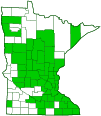Poke milkweed
(Asclepias exaltata)
Conservation • Wetland • Description • Habitat • Ecology • Use • Distribution • Taxonomy
Conservation Status |
|||
| IUCN Red List | LC - Least Concern |
||
| NatureServe | N5 - Secure SNR - Unranked |
||
| Minnesota | not listed |
||
Wetland Indicator Status |
|||
| Great Plains | FAC - Facultative |
||
| Midwest | UPL - Obligate upland |
||
| Northcentral & Northeast | UPL - Obligate upland |
||
Description
Poke milkweed is an erect perennial forb. A single stem rises from a large rhizome. The leaves and stems contain a milky juice.
The stems are erect, light green, and hairless.
The leaves are opposite, thin, elongated, 4″ to 8″ long, up to 3″ wide, and broadly elliptical. They taper to a point both at the tip and at the base. They are attached to the stem on ⅜″ to ¾″ leaf stalks. The upper surface is hairless. The margins are untoothed and may be slightly wavy.
The inflorescence is few to several loose, few-flowered, umbrella-shaped clusters (umbels) rising from the upper leaf axils.
The structure of the typical milkweed flower is unique and instantly recognizable. There are 5 petals bent backward at the base and hanging downward. Subtending the petals are 5 much shorter, light green, lance-shaped sepals. There are 5 stamens. Formed from the filament of each stamen is a petal-like appendage. The appendage consists of a tubular hood surrounding an awl-shaped horn in the center of the hood. The stamens and the stigma are fused together into a crown-like structure (gynostegium). Each stigma has a long slit designed to catch the legs of a pollinating insect. A small, dark, sticky gland above this slit is attached to pollen sacs from adjacent anthers. These glands are designed to break off as an insect pulls its leg free of the slit, and remain attached to the insects leg. The flowers are pollinated by larger insects strong enough to lift off with the pollen sacs attached. Smaller insects are caught in a death trap or leave behind their detached legs.
The flowers of this plant are shaped like the typical milkweed flower. They droop at the end of long, slender flower stalks. They are about ½″ tall and ⅜″ wide. The petals are green or green tinged with purple. They bend backward at the base, hang downward, then curl upward near the tip. They are separated from the hoods by a short but distinct column. The hoods are white or purplish-white. The horns are much longer than the hoods. They project from the hoods and are curved inwards.
The fruit is an elongated, pointed, spindle-shaped, 4¾″ to 6″ long pod. It is held erect or ascending on a downward-curved stalk. It opens on one side exposing the seeds to spreading by the wind. The seeds have a tuft of silky hairs at the tip.
Height
3′ to 5′
Flower Color
Green or greenish-white petals, white or purplish-white hoods
Similar Species
The thin leaves pointed at both ends, loose few-flowered umbels, and white or purplish-white flowers drooping at the end of long flower stalks distinguish this from other milkweeds in Minnesota.
Habitat
Moist. Upland woods.
Ecology
Flowering
June to July
Faunal Associations
Milkweeds are the only plants that Monarchs lay their eggs on. The eggs are laid on the underside of healthy young leaves.
Toxicity
This and other milkweeds contain cardiac glycosides and may be poisonous to both humans and livestock.
Pests and Diseases
Use
Distribution |
||
|
Sources 2, 3, 5, 7, 8, 22, 24, 28, 29, 30. Biodiversity occurrence data published by: Minnesota Biodiversity Atlas (accessed through the Minnesota Biodiversity Atlas Portal, bellatlas.umn.edu, 11/21/2025). |
|
| 11/21/2025 | ||
Nativity |
||
Native |
||
Occurrence |
||
|
||
Taxonomy
Kingdom
Subkingdom
Pteridobiotina
Phylum
Tracheophyta (Vascular Plants)
Class
Order
Gentianales (Gentians, Dogbanes, Madders, and Allies)
Family
Apocynaceae (dogbane)
Subfamily
Asclepiadoideae (milkweeds)
Tribe
Asclepiadeae
Subtribe
Asclepiadinae
Genus
Subordinate Taxa
Synonyms
Asclepias bicknellii
Asclepias nivea
Asclepias phytolaccoides
Asclepias syriaca var. exaltata
Common Names
poke milkweed
tall milkweed
Glossary
Axil
The upper angle where the leaf stalk meets the stem.
Clasping
Describing a leaf that wholly or partly surrounds the stem but does not fuse at the base.
Glaucous
Pale green or bluish gray due to a whitish, powdery or waxy film, as on a plum or a grape.
Gynostegium
A crown-like structure of plants of the genus Asclepias formed by the fusion of the anthers with the stigmas.
Linear
Long, straight, and narrow, with more or less parallel sides, like a blade of grass.
Rhizome
A horizontal, usually underground stem. It serves as a reproductive structure, producing roots below and shoots above at the nodes.
Umbel
A flat-topped or convex, umbrella-shaped cluster of flowers or buds arising from more or less a single point.
Visitor Photos
Share your photo of this plant.
This button not working for you?
Simply email us at info@MinnesotaSeasons.com.
Attach one or more photos and, if you like, a caption.
Luciearl |
||
Milkweed pods |
||
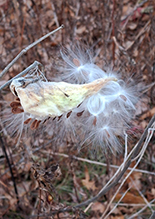 |
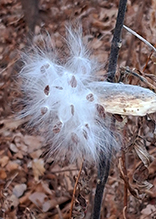 |
|
Found this growing along the Lake Shore trail. |
||
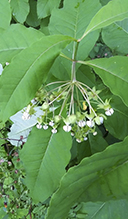 |
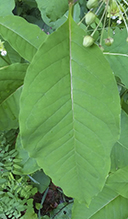 |
|
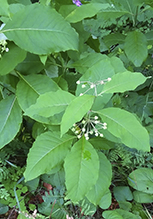 |
||
MinnesotaSeasons.com Photos
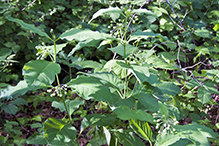 |
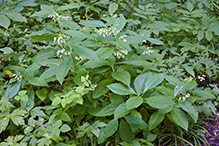 |
|
| Plant | Plant |
|
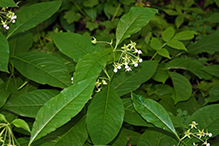 |
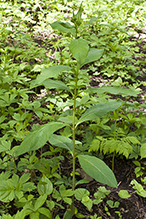 |
|
Plant |
||
|
||
|
||
Plant |
||
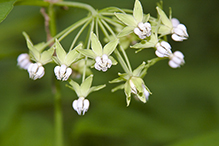 |
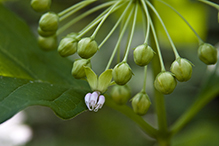 |
|
| Inflorescence | Inflorescence |
|
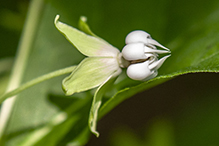 |
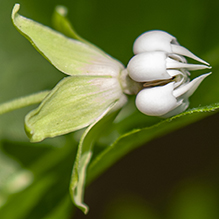 |
|
Flower |
||
|
||
|
||
|
Flower |
|
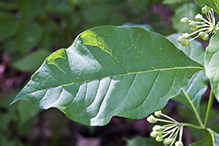 |
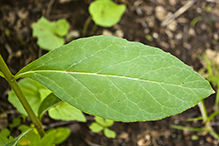 |
|
| Leaves | Leaves |
|
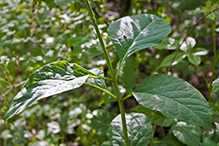 |
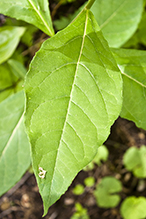 |
|
Leaves |
||
|
||
|
||
|
Leaves |

Slideshows

Visitor Videos
Share your video of this plant.
This button not working for you?
Simply email us at info@MinnesotaSeasons.com.
Attach a video, a YouTube link, or a cloud storage link.
Other Videos

Visitor Sightings
Report a sighting of this Plant.
This button not working for you?
Simply email us at info@MinnesotaSeasons.com.
Be sure to include a location.

